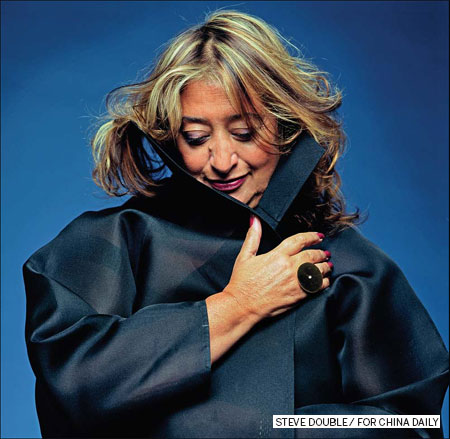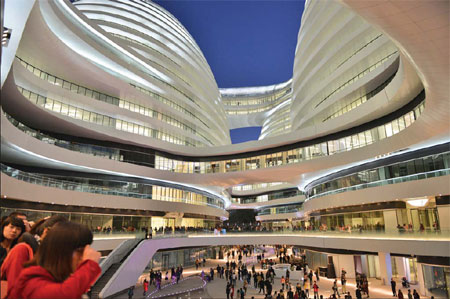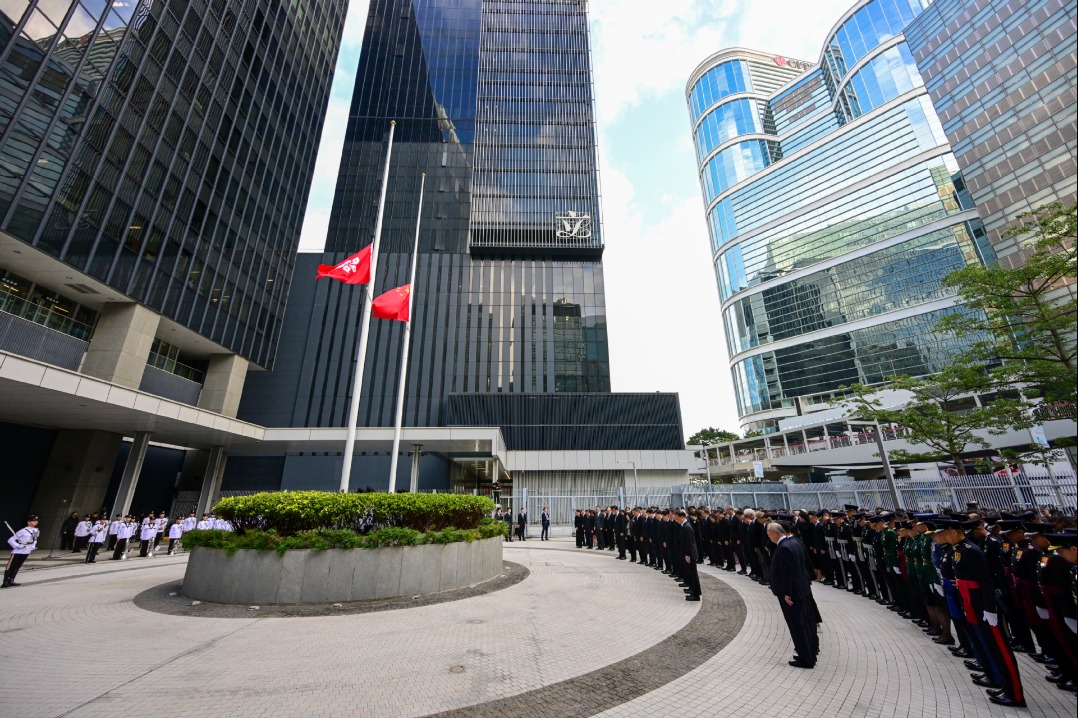Planetary presence


| Top: Zaha Hadid says silk and ancient gardens are among her passions. Above: Galaxy Soho in Beijing, which Hadid's architectural practice describes as a "re-inventing of the classical Chinese courtyard". Provided to China Daily |
The architect Zaha Hadid has left her mark on many countries, including china
There is a Chinese saying that travel is as important as reading the classics. For Zaha Hadid, the Iraqi-British architect who was the first woman to win the Pritzker Prize, there has never been a truer word. Her 47,000-square-meter Galaxy Soho, inspired by a trip to the Great Wall, was completed in October and is now a landmark in Beijing.
"I always thought that the Great Wall was like a motorway until I went to it and realized that it is a great hill; it is not continuous," Hadid says. "So the idea of Galaxy Soho's shape and line come from that.
"I have been inspired through travel, not only in China, but also in Europe and Latin America. I am not only inspired by the landscape but also by history.
"It is exciting; when you travel around the world you can find something in one place, and when you imply it in another place, it makes it unique in that place."
Just 20 years ago Beijing was a city with few landmark buildings, although those it did have were stunning and in many cases world-renowned. Today, modern icons such as the National Stadium and the CCTV Tower have joined the city's ancient architectural highlights in abundance.
Hadid will add more of her work to the landscape of China, inspired by the country's culture and her global wanderings.
China's ancient gardens and silk are among her passions. Travel has also played a part in this, her love of silk being born out of a trip to Suzhou.
In the coming years, Hadid designs will appear not just in the main Chinese metropolises but also in smaller places such as Chengdu in Sichuan province, Changsha in Hunan province and Nanjing in Jiangsu province. These cities are investing heavily in public institutions, including libraries, museums and opera houses.
In Chengdu, Hadid has been hired to design an art center, which will include a museum, exhibition center, teaching area and conference room, as well as bars, shops and restaurants.
Her soaring aerodynamic design for the building and its yin-yang shape are intended to evoke traditional Chinese symbols, her company says.
"It is mainly cultural buildings that I believe these second- or third-tier cities are competing with each other for. These cities are big cities, compared to those in the West in terms of size and population, and they are highly ambitious to develop."
Hadid believes cultural projects will be beneficial both for the development of art in China and the cities.
"That is what happened in Germany and France: museums, opera houses and concert halls are not just in Berlin or Paris. We can find interesting buildings in different cities. Cultural programs should not be restricted to certain areas."
That spirit of ubiquity is evident in Hadid's projects, located in Europe, the US, Asia and elsewhere.
While she is influenced by China's culture, she does not set out to make her designs look specifically Chinese in order to attract clients.
"I am not regional. There is no need to emphasize Chinese elements. I mean, I won't build something like a dragon; it should be combined with architecture and work functionally."
Xu Weiguo, a professor of architecture at Tsinghua University, says function, rather than image, should be the essence of architecture.
"Building kind of isolates people from nature, so one of the most important functions is to connect people with nature. Architects should focus on functions instead of image or cultural meaning.
"Many architects have something in their mind before they start, so the functions of their buildings somehow need to follow that framework.
"Hadid's style is a natural result of considering function and other elements; so it is better in terms of being a living and working environment."
Zhou Yufang, associate professor at the Central Academy of Fine Arts in Beijing, says second- and third-tier cities need talent from overseas.
"The fast urbanization of these smaller cities needs unique architecture to support it, and good architects can interpret sites well by reconfiguring the urban space."
While opportunities abound for architects in China, there is no shortage of criticism of modern buildings either. Time Magazine described the CCTV Tower in Beijing, designed by Rem Koolhaas, as a "unique tethrahedronal structure" that would be "the most radically re-imagined tall building in the world". But in China it has been widely criticized, many saying it looks like a pair of pants.
The Gate of the Orient in Suzhou was dubbed the CCTV Tower's brother, because it too is said to look like a pair of pants.
For Hadid the CCTV Tower "is a reconfiguration of a tower. It has a high building and low building and they are all well connected. It also has a nice skin. I don't understand why people don't like it."
Rapid development inevitably leads to comparisons between historical and modern buildings. For Hadid, it is important to preserve the old and create something new.
She cites Venice as an example.
"Venice is a very beautiful city. Nobody wants to build new buildings there. Everything is well preserved. But Venice is dead. There is no life. The population is not growing. It is unimaginable to demolish buildings in Venice, but it also means the city has stagnated.
"It is not about old buildings and new buildings. We have to think what the next generation requires, where they want to spend their time, what they want to do in that place."
Hadid says she appreciates the ambition of Chinese developers. She has known Zhang Xin, CEO of Soho China, for nearly nine years and admires her desire to break the old moulds of Chinese architecture.
"During periods of fast development cities change and become similar. A hundred years ago China did not have skyscrapers but now many cities have them. Cities lose some of their original identity. This is what is called progress.
"People will not argue about losing their original identity if they think you are building a good new one; they only do so when they find you are building a bad one."
Contact the writers at suzhou@chinadaily.com.cn and linjingcd@chinadaily.com.cn
(China Daily 12/14/2012 page28)
Today's Top News
- Xi stresses improving long-term mechanisms for cyberspace governance
- Experts share ideas on advancing human rights
- Japan PM's remarks on Taiwan send severely wrong signal
- Key steps to boost RMB's intl standing highlighted
- Sustained fight against corruption urged
- Xi calls for promotion of spirit of volunteerism































